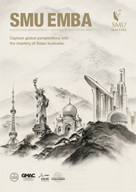
High-profile long-serving chief executive officers like Warren Buffet notwithstanding, the turnover of CEOs in the business world can be high. In fact, a record number of nearly 1,500 CEOs heading US-based companies left their positions in 2019, a 12 per cent increase from the year before.
Of these, some departures happened because of transgressions. In the case of McDonald’s Steve Easterbrook, for instance, he was fired because he had violated company policy by having a relationship with an employee. But while firing an errant CEO is one way for organisations to deal with these transgressions, it is not the only solution.
Assessing the impact of different organisational responses to such situations is the subject of a study conducted by Donald L. Ferrin, Professor of Organisational Behaviour and Human Resources in Singapore Management University’s Lee Kong Chian School of Business, along with the University of Miami’s Cecily D. Cooper, Washington University’s Kurt T. Dirks, and the University of Southern California’s Peter H. Kim.
Here are some of the findings and possibilities suggested by the study, as related in the article “Heads will roll! Routes to effective trust repair in the aftermath of a CEO transgression”.
1. Individual transgressions impact trust in the organisation
“When a CEO commits a significant transgression, there is much more at stake than simply the reputation of the CEO,” the authors state. “The leaders of an organisation reflect the organisation’s distinctive values, and any leader’s deviation from these values will harm the perceived integrity of the organisation.”
By negatively affecting a company’s ability to attract investment, talent and clients, such harm could even threaten its very survival. Therefore, it is very important for organisations to be proactive about repairing trust with their stakeholders, even if the transgression was carried out solely by the CEO.
2. Organisations have unique ways to repair trust
After committing a transgression, it is possible that a CEO may be motivated to act in the best interests of the organisation and do whatever is possible to repair trust in that organisation.
However, in cases where this doesn’t happen, organisations do have trust repair options that are not available to individuals. And these options can yield very different results in trust repair for the CEO and for the organisation.
For instance, an organisation can choose to fire its errant CEO. This action signals that the CEO does not share the values of the organisation and is often meant to prioritise trust repair for the organisation at the expense of the CEO’s reputation.
3. Sometimes, the fates of the CEO and the organisation remain intertwined
Firing an errant CEO is not always an option. Founder CEOs and those who have strong levers of power, for instance, are less likely to be dismissed. In such cases, organisational responses may try to repair trust in the CEO and the organisation concurrently.
For example, the organisation’s board members can prod the CEO to apologise and offer an act of substantive penance. This action can be effective, especially if stakeholders are convinced that the CEO regrets his or her actions, is committed to reforming personal shortcomings, and has resolved to behave differently moving forward. In other words, the extent of the CEO’s perceived repentance tends to influence the degree to which he or she regains the trust of stakeholders.
4. The importance of perceived repentance and entitativity
In fact, the study showed that the perceived repentance of the errant CEO not only positively impacted his or her perceived trustworthiness (both in situations of CEO dismissal and CEO apology and penance), but in the case of CEO apology and penance, also had a positive impact on the perceived trustworthiness of the organisation.
“Given the increasing evidence of the effectiveness of repentance, future research on trust repair might consider additional ways in which repentance can be signalled,” the authors note.
Another important factor in such situations is perceived entitativity, which refers to the extent to which others see a group as being unified. The study showed that perceptions that an organisation and its errant CEO were not aligned (or disentitativity) did not appear to boost trust in the organisation at the expense of the CEO. Rather, such perceived disentitativity directly facilitated negative perceptions of the CEO.
As such, “future trust repair research will benefit from further exploring how perceived entitativity/disentitativity may facilitate – or hinder – trust repair,” the authors believe.
5. The art of ambiguity
Another common response to CEO transgression is the resignation of the CEO. In the case of CEO departures, “It is often unclear whether the resignation is voluntary or forced by the Board,” the authors write, adding the same is true of CEO apologies.
“Such ambiguity is itself probably a useful instrument of trust repair (as organisations and CEOs may each exploit such ambiguity to their own advantage in their communications with trustors), and also a phenomenon worthy of future research.”
While the study found that trust repair can be achieved with the right responses by either the errant CEO or other individuals or entities such as the Board of Directors, ultimately, its authors hope that CEOs will avoid transgressions altogether. In most cases, the ramifications and challenges of trust repair – for both CEOs and their organisations – typically far outweigh any ‘benefits’ that may have arisen from the original transgressions.
Speak to our Admissions Advisors
Lee Kong Chian School of Business
Postgraduate Admissions
Singapore Management University,
SMU Administration Building
81 Victoria Street, Singapore 188065
Tel: +65 6828 0882
